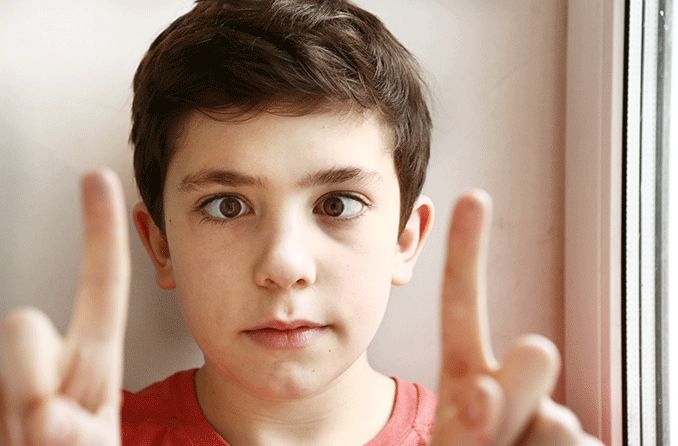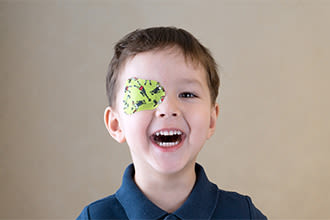Lazy eye (amblyopia)

Schedule an exam
Find Eye DoctorWhat is a lazy eye?
Lazy eye (also called amblyopia, the medical term for lazy eye) is a vision development disorder in which an eye fails to achieve normal visual acuity, even with prescription glasses or contact lenses. Lazy eye occurs early in life and can prevent your child from developing normal visual acuity in the affected eye.
Thankfully, there are treatments for the underlying causes of lazy eye. And if detected and treated early, poor vision from lazy eye can be avoided. Amblyopia typically begins during infancy and early childhood. In most cases, only one eye is affected. But in some cases, amblyopia can occur in both eyes.
If lazy eye is detected early in life and promptly treated, reduced vision can be avoided. But untreated lazy eye can cause permanent loss of vision in the affected eye.
It's estimated that about 2-3% of the U.S. population has some degree of amblyopia.
Symptoms
Lazy eye symptoms can sometimes be difficult to spot because amblyopia is typically a problem of infant vision development. Here are some of the easiest ways to determine if your child has a lazy eye condition.

You can help your child accept wearing an eye patch for lazy eye by making it fun.
Misalignment of the eyes — a condition called strabismus. If you notice your baby or young child has crossed eyes or some other apparent eye misalignment, schedule an appointment with an eye doctor near you immediately — preferably with an optometrist or ophthalmologist who specializes in children's vision.
If your child cries or fusses when you cover one eye. You can try this simple screening test at home by simply covering and uncovering your child's eyes (one eye at a time) when he or she is performing a visual task. If your child is not bothered when one eye is covered, but objects when the other eye is, this may suggest that the eye you have covered is the “good” eye, and that the uncovered eye is amblyopic, causing blurred vision.
Poor depth perception.
Repeated eye closure or squinting.
Eyes that don’t move in the same direction when the child is trying to focus.
A simple screening test is no substitute for a comprehensive eye exam. It's recommended to schedule your child's first eye exam at or around 6 months of age to make sure vision is developing normally and the eyes function together properly as a team.
What causes lazy eye?
There are three causes of lazy eye:
1. Strabismic amblyopia
Strabismus is the most common cause of lazy eye. To avoid double vision caused by poorly aligned eyes, the brain will ignore the visual input from the misaligned eye, leading to amblyopia in that eye (the “lazy eye”). This type of amblyopia is called strabismic amblyopia.
2. Refractive amblyopia
Sometimes, a lazy eye is caused by unequal refractive errors in the two eyes, despite perfect eye alignment. For example, one eye may have significant nearsightedness or farsightedness, while the other eye does not. Or one eye may have significant astigmatism and the other eye does not.
In such cases, the brain relies on the eye that has less uncorrected refractive error and “tunes out” the blurred vision from the other eye, causing amblyopia in that eye from disuse. This type of lazy eye is called refractive amblyopia (or anisometropic amblyopia).
SEE RELATED: Are nearsightedness and lazy eye the same thing?
3. Deprivation amblyopia
This is a type of amblyopia caused by something that obstructs light from entering and being focused in a baby's eye, such as a congenital cataract. Prompt treatment of congenital cataracts with cataract surgery is necessary to allow normal visual development to occur and prevent a visual disability from lazy eye.
Treatments for lazy eye
Treatment methods for amblyopia in children have evolved to offer a wider range of solutions, depending on the severity of the condition and preferences of the patient as well as their parents.
READ RELATED: Amblyopia treatments that can be done at home
Corrective lenses and glasses
In cases of refractive amblyopia (lazy eye due to unequal refractive errors), normal vision can be achieved simply by fully correcting the refractive errors in both eyes with glasses or contact lenses.
Usually, however, at least some patching of the “good” eye is needed to force the brain to pay attention to the visual input from the “lazy” eye and enable normal vision development to occur in that eye.
Strabismus surgery
Treatment of strabismic amblyopia (lazy eye caused by misaligned eyes) often involves strabismus surgery to align the eyes, followed by use of an eye patch on the dominant eye and some form of vision therapy (specific lazy eye exercises) to help both eyes work together equally as a team. It may be necessary to wear an eye patch for several hours each day or even all day long for several days or weeks to force the brain to start using the lazy eye normally.
In many cases of strabismic amblyopia, surgery must be performed to properly align the eyes before eye patching, atropine use and/or eye exercises for lazy eye will be effective. “Lazy eye surgery” is an incorrect term. The correct term to describe surgically straightening the eyes is “strabismus surgery.”
Sometimes, more than one strabismus surgery is needed to attain adequate eye alignment. Also, special eyeglasses with prism lenses might still be required after strabismus surgery to enable the eyes to work together as a team and for lazy eye treatment to be effective.
Prosthetic contact lenses
If you have trouble with your child taking off their eye patch, you might consider a specially designed prosthetic contact lens that prevents light from entering the good eye but does not affect your child's appearance.
Though prosthetic contact lenses are more costly than an eye patch and require a contact lens exam and fitting, they can work wonders in difficult cases of amblyopia treatment when compliance with eye patching is poor.
Atropine drops therapy
In some children, atropine eye drops have been successfully used to treat a lazy eye. One drop is placed in your child's good eye each day. Your eye doctor will give you instructions how to do this. Atropine blurs the close-up vision in the good eye, which forces your child to use the eye with amblyopia more, thereby strengthening the “lazy” eye without having to wear an eye patch on the good eye. One advantage of using atropine eye drops to treat lazy eye is that it doesn't require constant vigilance to make sure your child is wearing their eye patch.
In a study of 419 children younger than 7 years of age with lazy eye, atropine therapy produced comparable results to eye patching. (Improvement in visual acuity in the amblyopic eye was only slightly better in the patching group compared with the atropine group.) As a result, some previously skeptical eye care practitioners are using atropine as their first choice for amblyopia treatment over patching.
However, atropine does have side effects that should be considered — including light sensitivity (because the good eye is constantly dilated) and difficulty seeing near objects clearly during the treatment.
How to fix a lazy eye
For years, experts believed that if amblyopia treatment was not initiated very early in life, no improvement in visual acuity was possible. The critical period for intervention was said to be around age 8.
But it now appears that older children and even adults with long-standing lazy eye can benefit from amblyopia treatment using computer programs or apps that stimulate neural changes leading to improvements in visual acuity and contrast sensitivity.
One such program — called RevitalVision — has produced improved vision in older children with lazy eye and adults with long-standing amblyopia. The treatment generally consists of 40 training sessions of 40 minutes each, conducted over a period of several weeks.
In a clinical study of 44 children and adults with lazy eye (ranging in age from 9 to 54 years), 70.5% of the participants had a visual acuity improvement of two or more lines on a standardized eye chart after a full regimen of RevitalVision training sessions.
RevitalVision is FDA-approved for the computerized treatment of amblyopia in anyone age 9 and older with best corrected vision of 20/100 or better in the lazy eye and little or no strabismus.
SEE RELATED: Corneal light reflex
Don't worry, bangs don't cause lazy eye
You may have read recently that wearing long bangs over one or both eyes could cause visual problems and even produce a lazy eye over time. It's a myth. OK, it is sort of possible that bangs could cause a lazy eye, but only if:
It's a young child whose visual system is still developing.
One eye is so completely covered that the child can't see anything clearly with it.
The bangs cover the eye all waking hours of the day.
So if your child's bangs grow like weeds, don't worry about it. - L.S.
READ NEXT: What is Peters anomaly (PA)?
Correspondence from RevitalVision LLC. June 2010.
Perceptual learning improves contrast sensitivity and visual acuity in adults with anisometropic amblyopia. Vision Research. March 2006.
Atropine an effective alternative to patching for amblyopia. Review of Ophthalmology. October 2003.
A comparison of atropine and patching treatments for moderate amblyopia by patient age, cause of amblyopia, depth of amblyopia, and other factors. Ophthalmology. August 2003.
Page published on Monday, March 4, 2019






